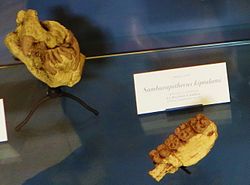Samburupithecus
|
Samburupithecus Temporal range: late Miocene |
|
|---|---|
 |
|
| Samburupithecus kiptalami fossils, Muséum national d'histoire naturelle, Paris | |
| Scientific classification | |
| Kingdom: | Animalia |
| Phylum: | Chordata |
| Class: | Mammalia |
| Order: | Primates |
| Superfamily: | Hominoidea |
| Family: | Hominidae |
| Subfamily: | ?Homininae |
| Tribe: | Dryopithecini |
| Genus: |
†Samburupithecus Ishida & Pickford 1997 |
| Species: | †S. kiptalami |
| Binomial name | |
|
†Samburupithecus kiptalami Ishida & Pickford 1997 |
|
Samburupithecus is an extinct primate that lived in Kenya during the middle to late Miocene. The one species in this genus, Samburupithecus kiptalami, is known only from a maxilla fragment dated to 9.5 million years ago discovered in 1982 and formally described by Ishida & Pickford 1997. The type specimen KNM-SH 8531 was discovered by the Joint Japan-Kenya Expedition at the SH22 fossil site in the Samburu District, a locality where several other researchers found no ape fossils.
Samburupithecus lived during the so-called "African ape gap" 14 to 7 Ma, a period from which very few hominoid fossils have been found in Africa until relatively recently. This apparent gap, however, is now populated by a diversity of apes such as Nakalipithecus, Chororapithecus abyssinicus,Otavipithecus, and Nacholapithecus.
Samburupithecus was approximately 60 kilograms (130 lb) and was most likely a frugivorous terrestrial quadruped. Paleoenvironmental reconstructions indicate that Samburupithecus most likely lived in a wooded habitat surrounded by savannah.
Defining cranial traits of this genus include low, broad zygomatics, straight alveolar process and large maxillary sinus. Defining dental traits include three-rooted premolars, thick enamel and bunodont cusps.
...
Wikipedia
